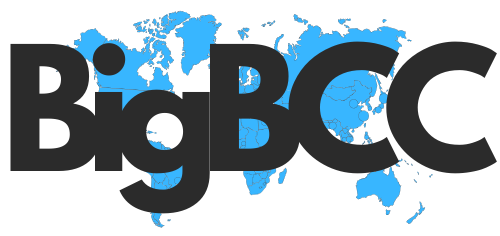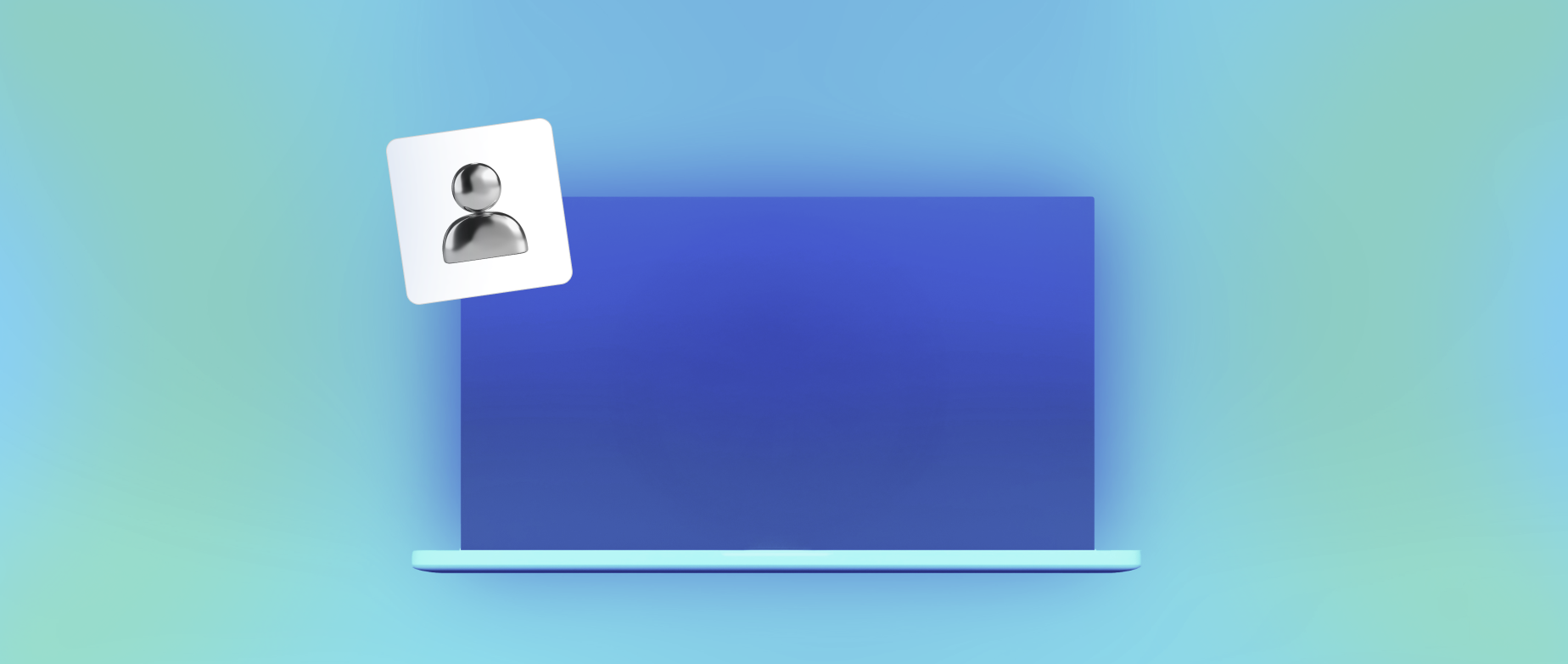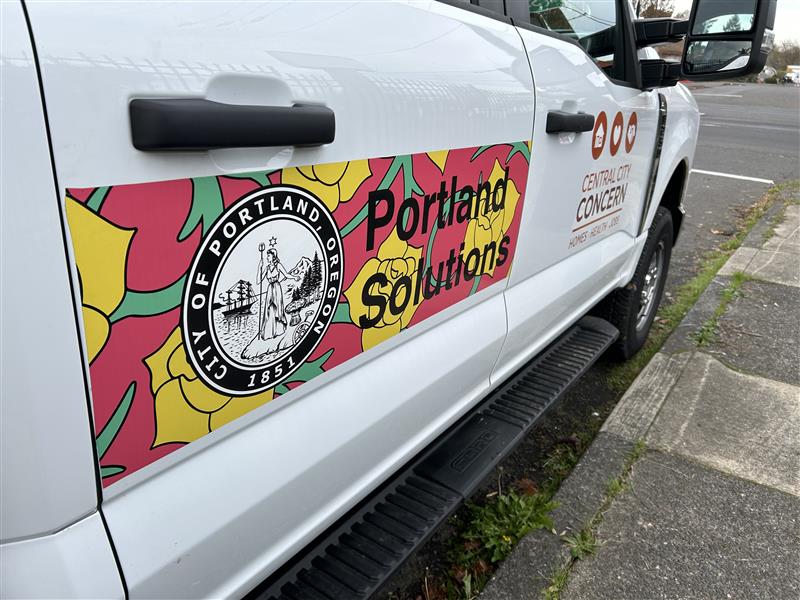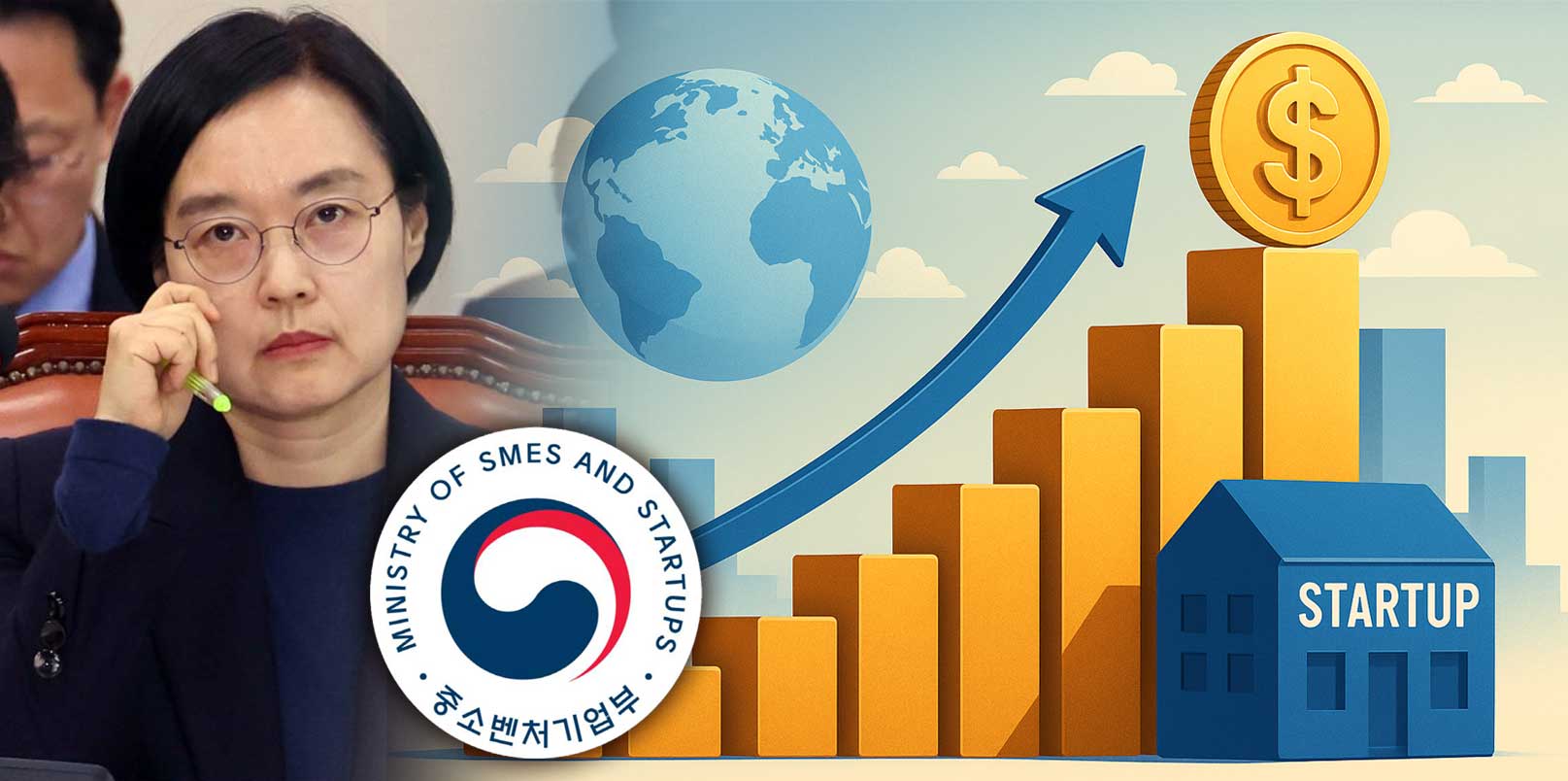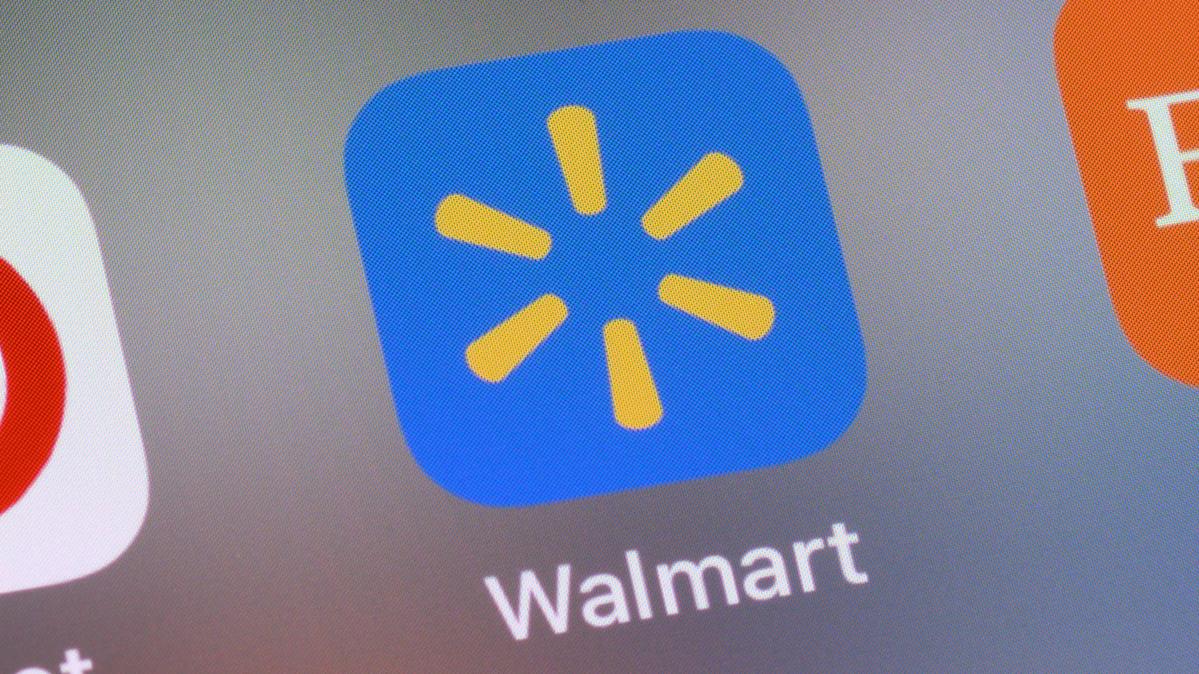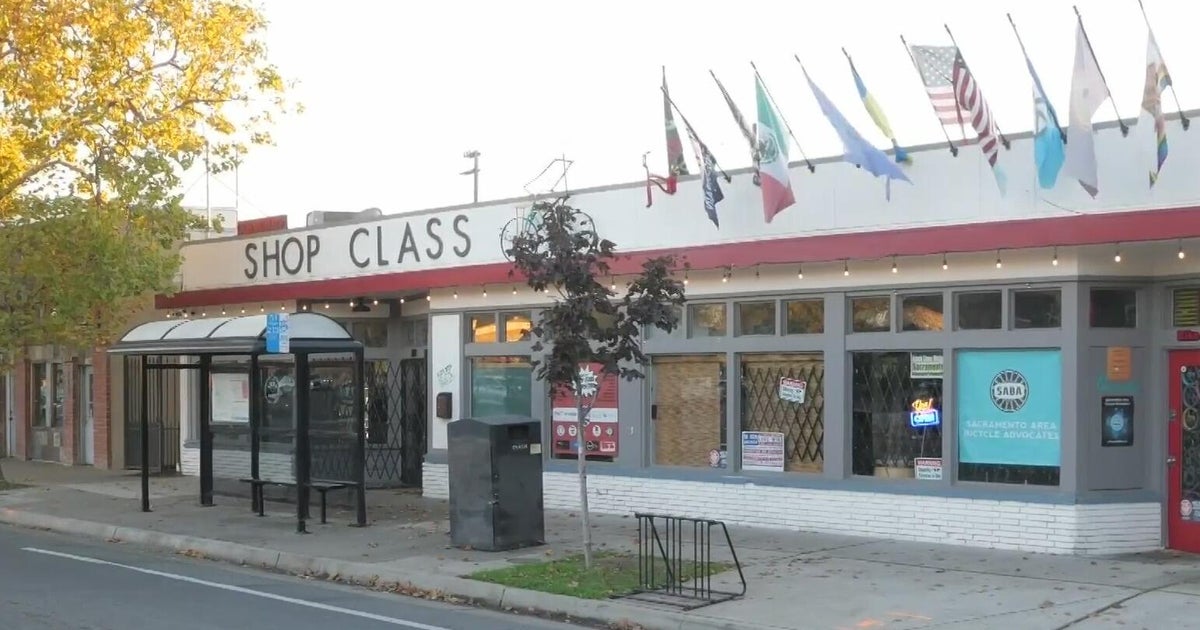B2B ecommerce is a multitrillion-dollar prize, and every manufacturer, wholesaler, and retailer wants a piece. But launching a wholesale subdomain and cold-emailing price lists won’t cut it anymore.
Business buyers today expect the same seamless experiences they enjoy as consumers, only with higher stakes and more zeros attached. Today, nearly 75% of B2B buyers expect suppliers to know when, where, and how they want personalized interactions.
Meet that bar, and you’ll shorten sales cycles, boost retention, and outmaneuver your rivals. Miss it, and even long-time accounts will switch to a competitor that makes buying feel effortless.
What is B2B ecommerce personalization?
B2B ecommerce personalization tailors every part of the buying experience—such as catalogs, pricing, self-service portals, and checkout flows—to each business account and its individual stakeholders.
It relies on first-party data synced across your storefront, as well as your enterprise resource planning (ERP) and customer relationship management (CRM) systems. Each buyer interacting with your store sees product content, pricing, and terms that match their role and purchase history.
Core principles of B2B personalization include:
- Account-based profiling: Segment by firmographic data (industry, annual spend, region) and deal stage to present the right SKUs, terms, and payment options.
- Role-aware experiences: Procurement managers care about price tiers and delivery windows; engineers want spec sheets. Personalization understands these distinct priorities and gets the right data in front of the right people to make their job easier and get them closer to a purchase.
- Real-time data unification: Tie storefront, ERP, CRM, and sales rep activity into a single view, so pricing rules and content decisions update instantly.
- Dynamic catalogs and pricing. Display contract pricing, volume discounts, and negotiated payment terms automatically at sign-in.
- Governance and privacy. Personalization depends on customer data and clear permissions, staying compliant with GDPR, CCPA, and customer IT policies.
Overall, B2B buyers are willing to trade data for value. A study from Adobe and Forrester found buyers are twice as likely to share data with an organization if they receive the personalized interactions they want.
How B2B personalization differs from B2C
B2B and B2C ecommerce personalization differ in several ways. B2B serves buying committees, negotiated price lists, and repeat replenishment, which are factors that don’t exist when a single B2C shopper makes a quick, one-off purchase.
| Difference | B2C ecommerce | B2B ecommerce |
|---|---|---|
| Buying unit | Single shopper | Buying groups (often between 6 and 10 people) |
| Pricing | Public MSRP and promos | Contract, volume, or customer-specific price lists |
| Purchase cadence | One-off or seasonal | Recurring or scheduled |
| Deal value | $20 to $2,000 | Often upwards of $500,000 |
| Decision drivers | Convenience and emotion | Risk, ROI, compliance |
The evolution of B2B buyer expectations
Business buyers have brought their consumer habits into the workplace. They expect the same quick, self-serve journeys they enjoy when shopping for themselves, but with pricing tiers and stakeholder approvals layered in:
- Digital-first mindset: IDC found that 74% of today’s tech buyers plan to rely more on ecommerce and less on sales reps than they did in 2020.
- Comfort with self-service: McKinsey reports that 73% of buyers are now willing to spend more than $500,000 online in 2024, up from 59% in 2022.
- Omnichannel retail as the baseline: McKinsey also found that business customers now use an average of 10 interaction channels (double the five they used in 2016), and more than half will switch suppliers if they can’t move seamlessly between those channels.
Meeting these expectations is no longer optional. It’s the cost of entry for winning and retaining high-value B2B accounts in the coming years.
The business case for B2B personalization
Smart ecommerce personalization does three things for a B2B brand: it grows the top line, keeps customers coming back, and gives buyers a reason to choose you over a cheaper lookalike.
Revenue impact and conversion improvements
Adobe’s 2025 Personalization at Scale report shows companies that personalize every stage of the account journey are twice as likely to beat revenue and conversion goals—and most post three-year gains of 20% or more.
Furniture brand Industry West shows how personalization can pay off. After migrating their trade storefront to Shopify, they rolled out custom catalogs personalized for architects, designers, and commercial buyers. After using the power of personalization to show these customers precisely what they needed to see, the brand’s B2B revenue from online orders climbed 90%, and average order value (AOV) rose 20% in the first year.
👉 Read Industry West’s story.
Customer retention and loyalty benefits
Personalization in B2B accelerates repeat orders and reduces churn. Buyers stick with suppliers who treat them like partners, not transactions. Forrester’s 2024 CX Index shows these “customer-obsessed” brands experience 51% higher retention than their peers.
Dermalogica Canada backs that up with real-world results. After moving their wholesale portal to Shopify and adding loyalty-tier pricing, saved cards, and one-click reorders, the brand cut the average gap between purchases from 47 days to 11. As a result, conversion climbed from 74% to 92%, and 75% of buyers now rate the customer experience 4 out of 5 or higher.
👉 Read Dermalogica Canada’s story.
Competitive differentiation in commoditized markets
When products feel interchangeable, buying experience makes the difference. A Sana Commerce survey found 74% of B2B buyers would switch suppliers if another vendor’s web store delivered a smoother experience—a figure rising to 91% among US buyers.
TileCloud, an Australian tile retailer in a crowded category, launched a dedicated Shopify B2B store with personalized price lists and a streamlined checkout. Within one year, TileCloud saw a 24% surge in wholesale sign-ups and a 34% jump in average order value.
👉 Read TileCloud’s story.
Core components of B2B personalization
A high-converting B2B experience includes four core components.
Custom pricing and catalogs
Wholesale buyers expect to see the correct numbers the moment they sign in. Seeing standard prices and having to root around and confirm negotiated rates is offputting and time-consuming. With Shopify, you can attach negotiated rates, volume breaks, and net-payment terms to each company profile, automatically reflecting those numbers from sign-in through checkout.
Australian fragrance label WHO IS ELIJAH used this approach across eight expansion stores. Once each region had its own catalog and price matrix, international wholesale revenue climbed 50% year over year.
“One of the reasons we needed custom pricing for our wholesale customers was that many of them fall into different B2B categories; some have hard margins, and some we can control,” says the brand’s technical leader, Brylee Lonesborough. “The custom catalog capabilities in B2B on Shopify meant we could set individual pricing categories and attach them to the various types of B2B customers we have so they get a more personalized experience.”
Now, WHO IS ELIJAH is exploring Shopify’s latest AI-powered tools, such as Shopify Sidekick, to further streamline operations and maximize business performance.
Account-based content and messaging
After price, the next thing buyers look for is relevant information and messaging—and right now, many aren’t getting it. In a recent Forrester survey, 18% of brands saw declines in their customer experience scores. Just 1% improved.
With Shopify’s Customer Accounts, you can shift the narrative. Buyers log in once and unlock a storefront that greets them by company, shows only approved collections, and highlights account-specific data on every product card.
You can also build segments, like “North-East distributors with open quotes,” “OEM buyers over $250K LTV,” and feed them to Shopify Email or Klaviyo for email campaigns with copy that speaks the buyer’s language (lead times, pallet minimums, spec sheets, etc.). Because content, pricing, and CRM data share a unified data model, marketing and sales stay in sync, and buyers see a site that feels built for them.
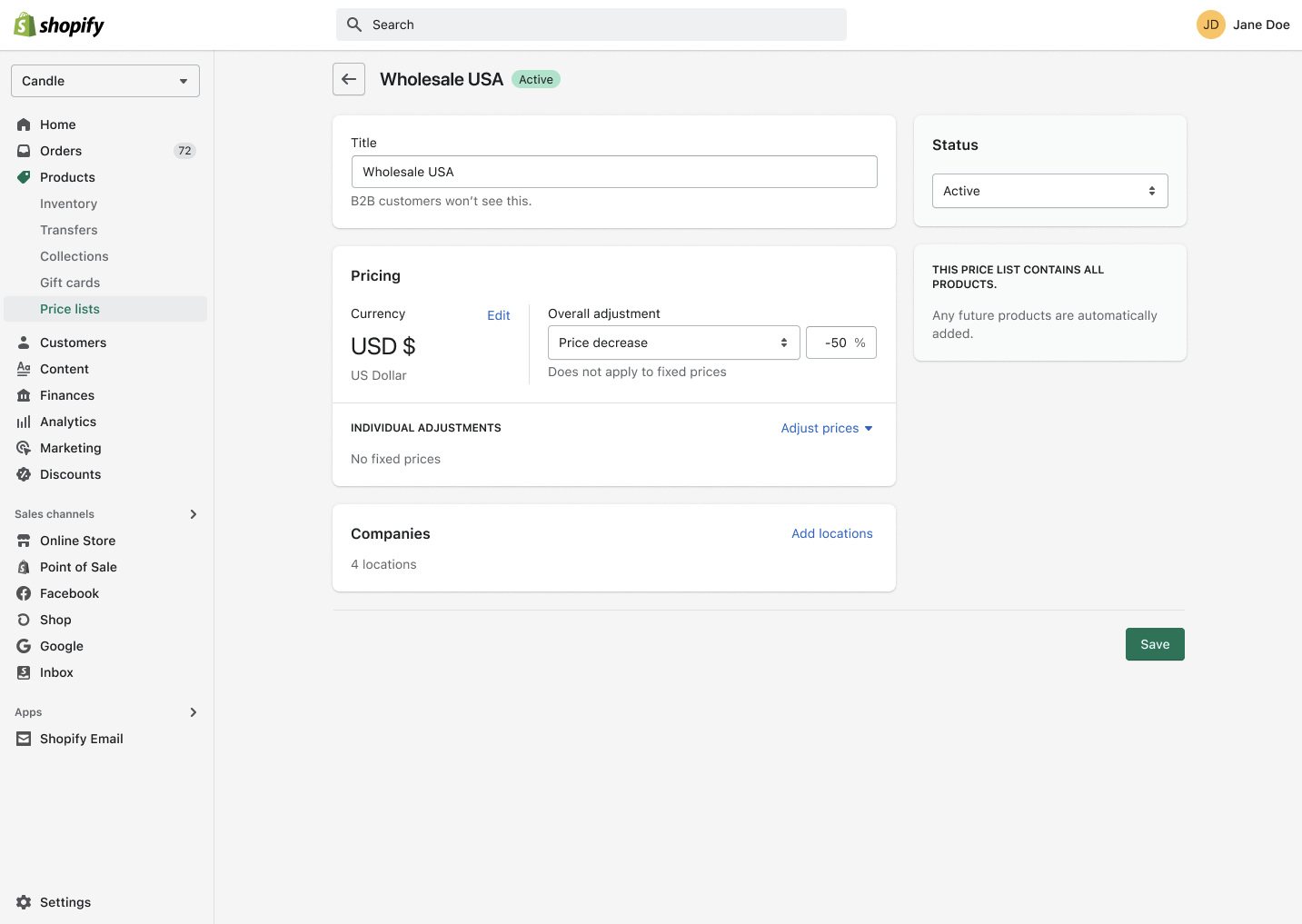
Product recommendations and cross-selling
Procurement teams don’t toss extras into a cart for fun. They add them when they’re certain of the value, and the prices make sense. That’s why personalized suggestions boost sales.
DECKED, a retailer of truck-bed storage to fleet operators and trade contractors, put this into practice after moving to Shopify. The team used the Search & Discovery app plus a post-add-to-cart customizer that suggests compatible rails, tie-downs, and protective cases.
Half of buyers now accept at least one suggested add-on, driving a 4% revenue lift without the need for discounts. “We can match dealers not just by proximity and location, but also based on those who have our product displays or only carry specific items from our range,” says Taylor Straley, VP of ecommerce at DECKED.
“This capability allows us to tailor our customer experience and product discovery recommendation efforts more effectively. Importantly, it benefits the customer by enabling us to gather and utilize search and contact data, ensuring a direct connection from our website to the appropriate dealer.”
Self-service portal personalization
Among the 71% of B2B companies that run an ecommerce storefront, that channel generates 34% of their total revenue—more than any other channel. Recognize your B2B ecommerce storefront for the powerhouse it is by giving buyers an easy-to-use portal that works the way they do, and they’ll reward you with revenue.
Some ways to personalize a B2B portal include:
- Offer role-based dashboards that control user access and permissions. Individuals appreciate it when you recognize them, not just their company.
- Use quick-add grids and saved carts so routine purchase orders (like “200 units of SKU-A every 30 days”) can be dropped straight into checkout.
- Automate low-stock alerts (“You’re down to 10 units, want to reorder?”), contract renewal reminders, or multi-step approvals when an order tops a spend threshold.
- Provide self-serve support that pulls order history into chat, so buyers get personalized help.
None of this could be possible without a powerful B2B ecommerce platform like Shopify. The Shopify B2B toolkit puts price lists, user roles, and automations in one place, so you can create a personalized portal without custom code. That frees your team to build better supplier relationships and increase revenue.
Superfood brand Laird Superfood ditched phone-in wholesale orders for a password-protected Shopify portal. The switch saves them $50,000 to $60,000 in labor each year, and flipped the revenue mix—wholesale now accounts for 75% of total sales, up from 25% before the move.
B2B personalization strategies that drive results
Behavioral segmentation and targeting
Brands want clear-cut segments, but getting there is challenging—most still toggle between 7 to 10 different tools every time they need to build a segment or launch a campaign. This complexity creates data gaps and kills productivity.
Shopify streamlines segmentation and targeting:
- Web pixels and customer events APIs capture every tap, scroll, and checkout in real time—client-side and server-side—alongside any data coming in through Klaviyo, Mailchimp, and other third-party sources.
- All events land in a unified customer model that resolves identities automatically.
- Customer segmentation tools then turn these events into cohorts, like “buyers who viewed three SKUs and abandoned a $5K cart in the last 48 hours.”
Plus, with Shopify Audiences, you can retarget buyers based on the data you collect. Anonymized purchase data is gathered from all retailers who opt in and used to build Retargeting Boost lists that double conversions for every dollar you spend on remarketing.
The same co-op data powers lookalike lists that cut customer acquisition costs by up to 50% compared with platform targeting alone. And because Shopify Audiences, Shop Campaigns, and Collabs share the same data layer, you can turn a high-intent segment into an ad set, influencer promotion, or affiliate offer without rebuilding the list.
💡 The upshot: A single source of first-party truth, segments that refresh themselves, and campaigns launched the same day insights emerge.
Personalization based on purchase history
Reorder data is your highest-intent signal, yet most teams still mine it with CSVs and manual “repeat-buy” emails—slow, siloed, and easy to ignore.
With Shopify, you can turn purchase history into a personalization engine:
- Enable smart reordering. Make it effortless for buyers to repurchase the products they rely on. For B2B customers who order consumables, components, or standard supplies, create a personalized “Quick Reorder” portal within their account page.
- Offer cross-sells and upsells. Use purchase history to offer recommendations that add real value. If a customer buys a specific piece of machinery, automatically recommend compatible accessories, replacement parts, or service plans.
- Create targeted new product announcements. When you launch a new product, don’t notify everyone. Create a segment of customers who purchased similar or previous versions of that product. Send them a targeted campaign announcing the upgrade, highlighting new features and offering an exclusive discount.
- Automate replenishment reminders. For products with a predictable lifecycle, use purchase data to anticipate customer needs. If a buyer purchases a filter that needs to be replaced every 90 days, schedule an automated email reminder that will go out around day 80.
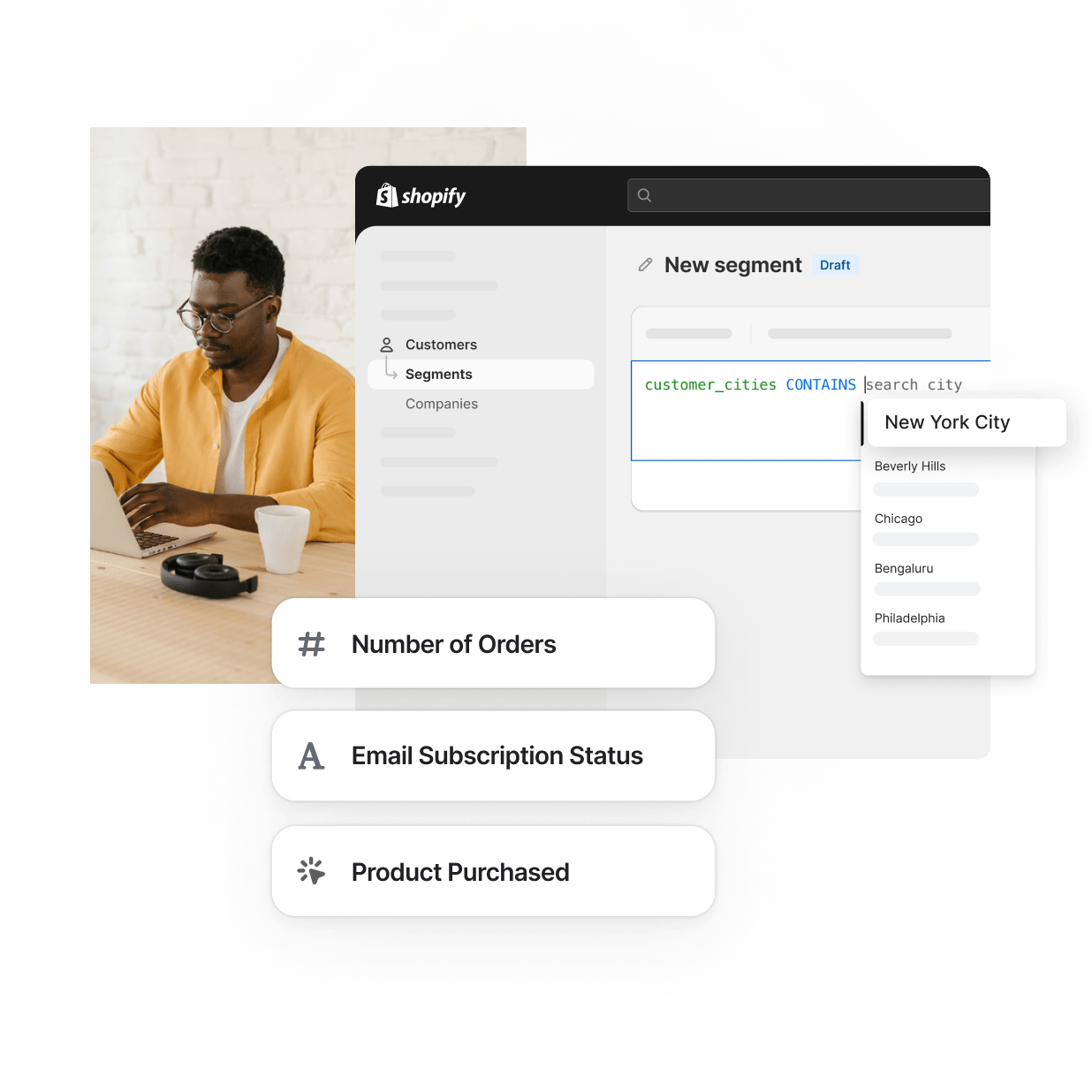
Role-based content delivery
Within a single client company, multiple stakeholders are often involved in purchasing decisions, and each has unique needs. Dynamic content simplifies the decision-making process for everyone involved and makes your business easier to work with.
Once you build your segments, you can deliver the information each role needs, when they need it. For example, when a procurement manager logs into their portal, they get a simplified interface with quick order forms, access to previous invoices, and prenegotiated pricing visible directly on the product page. When an executive logs in, they see financial metrics, ROI calculators, and articles about industry trends.
Combine role-based content with targeted email campaigns based on each contact’s job title, built with Shopify segmentation tools. Contacts with a job title including “procurement” might receive an email explaining how easy it is to generate an invoice. Those tagged as “executive” get quick links to access your ROI calculator and relevant case studies tailored to their industry.
Technology stack for B2B personalization
Customer data platforms (CDPs) and unified profiles
B2B personalization requires a unified data model. Shopify does this automatically by linking buyers to their parent company record, capturing roles, negotiated price lists, and tax status in one place. Purchase order approvers see the same catalog, with contract pricing already applied at checkout.
Segmentation tools let you filter by order frequency, customer tags, net spend, and more. You can easily send automated reminders to buyers who haven’t replenished consumables, for instance, after 30 days.
WHO IS ELIJAH moved their wholesale portal from Salesforce to B2B on Shopify, rolling out eight expansion stores across Australia, the UK, the US, and New Zealand. Combining custom catalogs, localized pricing, and a single Shopify dashboard for all sales data, the brand achieved 50% year‑over‑year international B2B growth in 2024 and a 46% AOV lift during Black Friday.
👉 Read WHO IS ELIJAH’s story.
Personalization engines and AI tools
It’s clear that buyers expect suppliers to predict their needs, and winning teams respond with AI. B2B teams that pair Gen AI with data‑driven personalization are 1.7 times more likely to grow market share than peers who don’t.
Shopify offers multiple ways to automate and personalize the B2B shopping experience:
- Shopify Functions rewrites prices, discounts, or shipping rates at checkout the instant buyers commit, so contract pricing and volume breaks feel native.
- Shopify Flow monitors intent signals (cart value, SKU mix, repeat‑order cadence) and fires instant actions, like tagging the account as “VIP” and emailing a rep with net‑30 terms.
- AI recommendation apps (such as Rebuy, Nosto, and LimeSpot) display “buy again” prompts, smart bundles, and semantic search results that learn from every session.
- Search & Discovery lets you pin high-margin SKUs and auto-generate product recommendations in the search bar. Buyers can also search with natural language, so queries like “14‑gauge stainless fittings under $4” return perfect matches.
Integration with ERP and CRM systems
B2B buyers want instant answers on stock, contract pricing, and order status. When those data points live in separate silos, every quote or “Where’s my order?” email drags out sales cycles.
Outdoor gear supplier DARCHE moved from OroCommerce to Shopify, connected their ERP, and launched Shopify B2B features like company profiles, custom catalogs, and personalized price lists. The shift enabled wholesale buyers to place self‑serve orders through tailored catalogs, helping DARCHE project a threefold year‑over‑year increase in B2B sales while cutting manual phone and email orders.
⚡️Tip: Shopify integrates with apps like NetSuite, Acumatica, and Brightpearl. Eliminate manual entry—and therefore, improve data accuracy—with native integrations that pull data in real time, placing your most important metrics in a single dashboard.
Analytics and optimization platforms
B2B personalization delivers compounding returns when you treat every click, chat, and checkout as a clue, and then test the fix.
Analyze real‑time actions to catch patterns. For example, a jump in orders from mid‑market distributors might warrant a bulk-buy bundle. An uptick in identical chatbot questions usually flags friction at checkout. Turn these events into features that drive smart search and on‑page recommendations, steering buyers to the right SKU even when their query is off by a word.
The Shopify QL Notebooks app improves data intelligence by letting you query, explore, and visualize your business data. For example, you can:
- See which geographic regions or market tiers drive revenue.
- Track reorder cadence for VIP accounts.
- Uncover breakout SKUs from recent quarters or high-volume buying periods.
- Understand where in the funnel B2B buyers abandon carts.
- Compare month-over-month performance to see if personalization is working.
Open a notebook in the admin, drop in a code cell, and write a question in ShopifyQL—a commerce‑aware language that feels like pared‑back SQL but recognizes terms such as “product_title” or “sales_channel.” Hit “Run” and the cell returns a data grid and a chart picker powered by Polaris Viz, the same visualization system that drives Shopify’s Live View.
Need a line chart of net sales or a bar chart of average order value by company tier? Add the VISUALIZE keyword and pick the chart style—line, bar, area—directly inside the notebook. Non‑technical teammates can toggle dimensions or time frames without rewriting the query.
Implementation roadmap and best practices
Getting started with basic personalization
The best way to begin with B2B ecommerce personalization is to leverage the data you already have. Start with foundational tactics that deliver immediate value to you and your customers.
- Use templates to instantly segment customers. You don’t have to build audience segments from scratch. Shopify includes a growing collection of ready-made templates that quickly highlight key groups. Instantly find buyers likely to spend more, reconnect with one-time purchasers, or target customers who abandoned a checkout.
- Create custom segments with tags. For more specialized groups, use customer tags to segment by industry, location, or business type (e.g., wholesale, distributor, tax-exempt).
- Send targeted content. Once created, your segments update automatically as new customers arrive and existing ones evolve. Use these dynamic groups to send targeted email campaigns, offer exclusive discounts, or automate marketing workflows that speak directly to each B2B buyer exactly when it matters most.
💡 Tip: With apps like Nosto from the Shopify App Store, you can also show or hide specific content, like promotional banners, to logged-in customers based on their tags.
Advanced personalization techniques
Once you’ve mastered the basics, you can implement more powerful strategies to create truly unique buying experiences, especially with the advanced features available on Shopify.
- Leverage custom data with metafields. B2B relationships depend on capturing unique data. Use metafields to add custom attributes to your customer profiles, such as their industry, contract terms, or assigned sales representative. Then use these metafields to build hypertargeted segments for bespoke marketing and onsite experiences.
- Implement dynamic catalogs and pricing. Use B2B catalogs to assign custom product selections and specific price lists to different companies. Further refine the buying experience by setting volume pricing to reward bulk purchases and enforcing quantity rules on orders, giving each B2B client a tailored procurement experience.
- Explore headless commerce. A headless architecture offers unlimited personalization. Using a framework like Shopify Hydrogen, you can build a completely custom B2B portal with complex order forms, multi-level user permissions, detailed technical specs, and dashboards for reordering. Hydrogen is built for speed, delivering near-instant page loads that make browsing large catalogs and placing complex orders much faster.
💡Did you know? A headless build with Hydrogen enables smoother, more flexible integrations with the essential systems that power B2B operations, such as ERPs (for inventory and pricing), CRMs (for customer data), and PIMs (for product information).
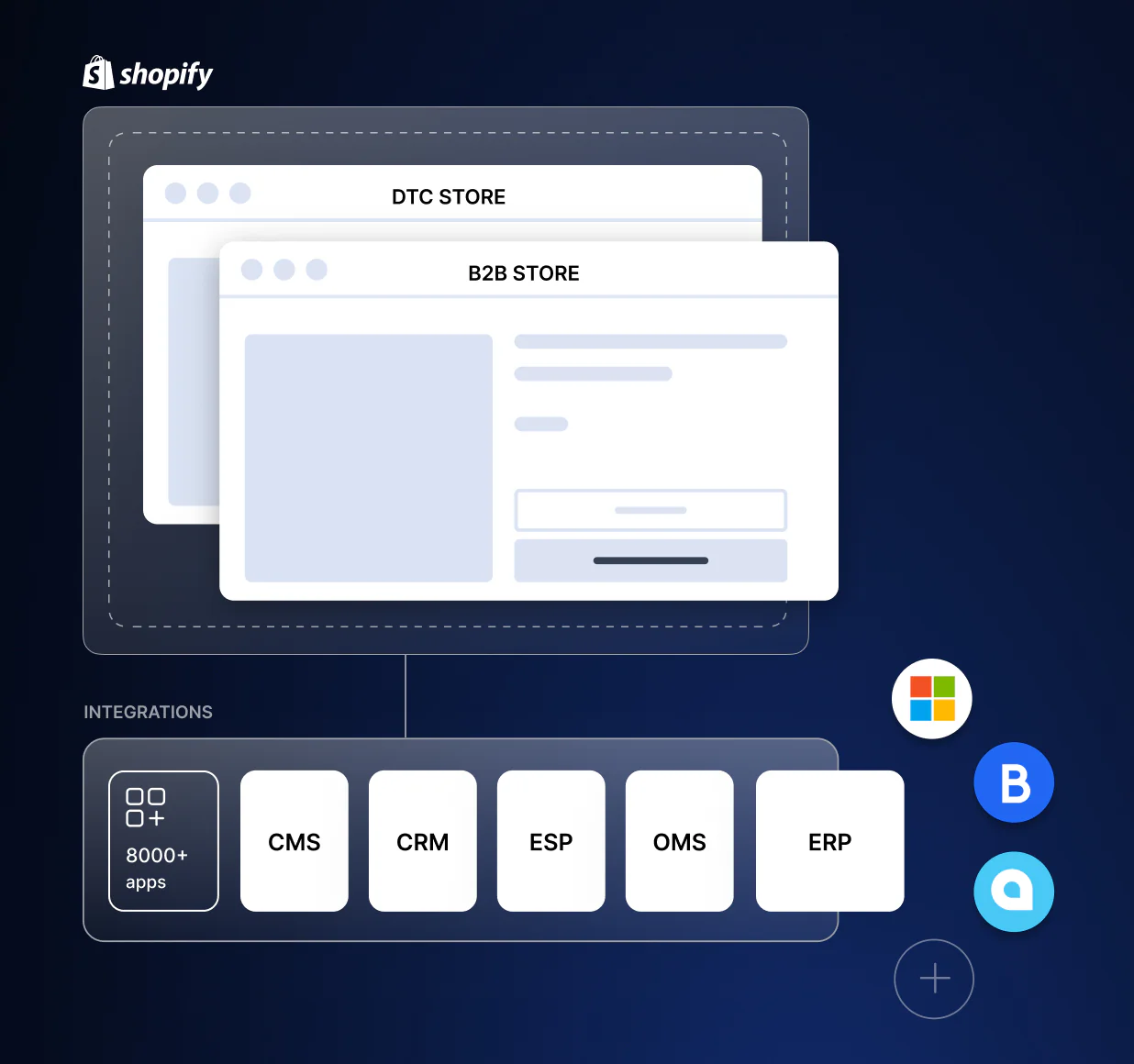
Measuring success and optimization
To ensure your efforts are paying off, you need to track performance and continuously optimize.
Focus on these key performance indicators (KPIs):
- Conversion rate: Are personalized experiences turning more browsers into buyers?
- Average order value (AOV): Are personalized recommendations and custom catalogs encouraging larger purchases?
- Customer lifetime value (LTV): Is personalization building loyalty and driving more repeat business over time?
- Abandoned checkout recovery rate: Are your personalized reminder emails for specific segments recovering more revenue than generic ones?
Use Shopify Analytics to build reports and track these metrics. Filter your reports by customer segments to see the direct impact of your personalization efforts and use A/B testing to continuously improve your strategy.
Common pitfalls and how to avoid them
As you implement your B2B personalization strategy, be mindful of these common challenges.
- Data silos: When data is scattered across ERP, CRM, and commerce platforms, you can’t get a clear picture of your customer. Use Shopify’s unified commerce capabilities and third-party apps to sync your systems and create a single source of truth for each account.
- Ignoring data privacy and trust: Personalization requires customer data, and customers are rightly concerned about how it’s used. Be transparent and prioritize consent. Use Shopify’s built-in tools for compliance with privacy regulations like GDPR and CCPA. This allows you to reassure your customers that their information is safe, and frame personalization as a benefit that offers them a better, more efficient experience.
- The “creepy” factor: Displaying too much specific data can make customers uncomfortable rather than supported. Focus on B2B personalization that provides clear value—saving the customer time, simplifying complexity, or offering relevant discounts. Good personalization should feel like excellent customer service, not surveillance.
The future of B2B personalization
AI and machine learning trends
Generative AI is evolving into an integral part of business operations. McKinsey found that 78% of companies already deploy AI in at least one business function, up from 72% in early 2024, and 92% of executives plan to boost AI spend again over the next three years.
Buyers are racing ahead of sellers. Forrester reports that 89% of B2B buyers now rely on GenAI tools during every stage of their research and purchase journey.
Teams are putting AI into practice in several ways:
- GenAI scrapes CRM notes, public filings, and news to create tailored pitch decks.
- LLM chatbots provide real‑time inventory, contract pricing, and spec sheets to answer RFQ questions.
- Recommender systems learn from order history and session behavior to surface “buy‑again” prompts or volume‑based bundles.
- Algorithms ingest margin targets, competitor moves, and buyer elasticity to adjust contract tiers or spot pricing in near‑real time.
- Models monitor engagement signals and prescribe whether to nudge, upsell, or escalate to a human.
Shopify’s own generative duo—Magic and the Sidekick assistant—put this power directly into the admin you already use. Magic turns a single prompt into on‑brand product copy, replenishment emails, or FAQ answers that draw from your store data, so the language resonates with each buyer segment.
Ask Sidekick, “Why did wholesale revenue dip last week?” and it pulls the numbers from your ShopifyQL dashboards, explains the drop, then offers to spin up a Flow that nudges lapsed accounts.
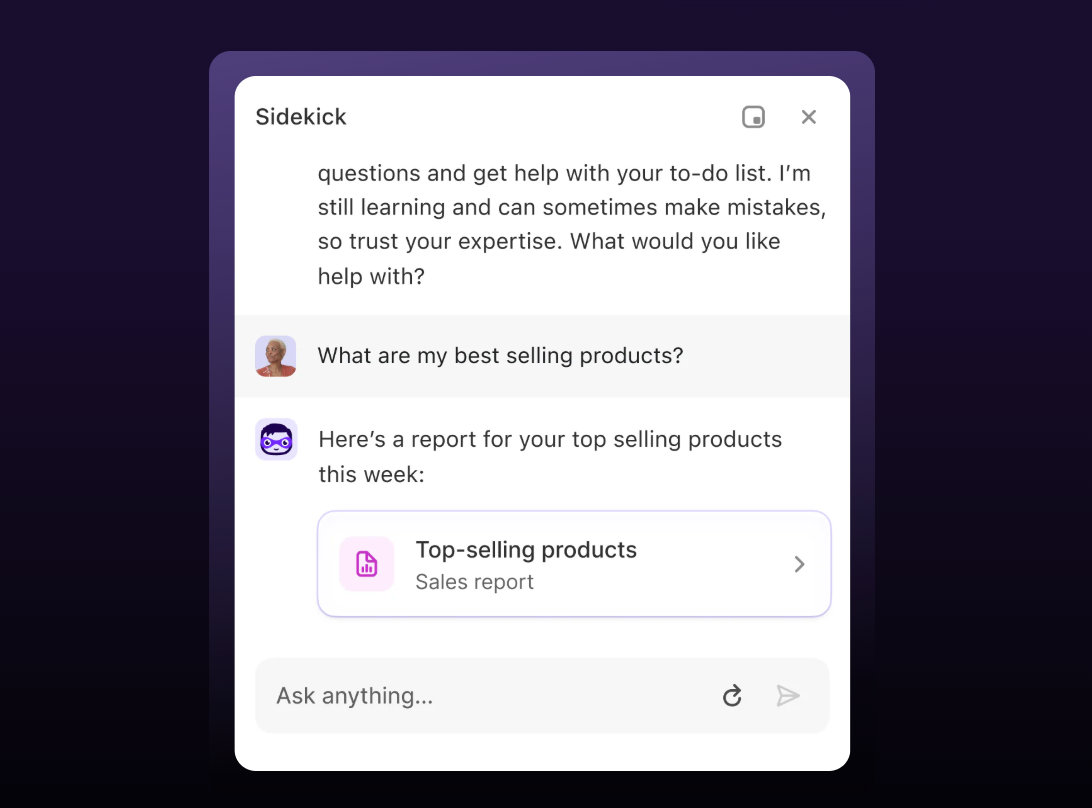
Emerging technologies and capabilities
Next‑gen tooling is arriving fast, and buyers already expect it. About 48% of B2B manufacturers say AR/VR is their top tech investment for 2025 , and real‑time 3D visualizers are now influencing big‑ticket decisions.
Shopify’s AR supports 3D files in popular USDZ and GLB formats out of the box, so buyers can spin a machine part or place a modular display in their showroom before ordering. Composable commerce stacks—Hydrogen storefronts on Oxygen or other headless front ends—let brands incorporate these new technologies without replatforming.
Preparing for next-generation buyer expectations
Millennials and Gen Z aren’t just future B2B buyers anymore. They run the show. This cohort makes up 71% of all B2B buyers—up from 64% the year before.
Younger generations grew up on one‑click B2C shopping, and expect the same ease at work. By the end of 2025, Forrester predicts more than half of million-dollar B2B deals will close via the self‑serve channels that digital natives prefer.
B2B ecommerce personalization FAQ
What’s the difference between B2B and B2C personalization?
B2B personalization targets accounts with multiple stakeholders. It must honor negotiated contracts, tiered pricing, and ERP/CRM data feeds. In B2C, you tailor offers to a single consumer within seconds, with list-price SKUs and no committee approvals.
How much does B2B personalization cost to implement?
Costs vary with scope. Merchants on platforms like Shopify can start with built-in segmentation and automation for a few hundred dollars per month, while enterprise rollouts with a CDP, AI recommender, and ERP integration can reach six figures.
What data is needed for effective B2B personalization?
Start with first-party data—order history, contract terms, catalog entitlements, and payment behavior from your ERP and ecommerce platform. Enrich this with firmographics (industry, region, revenue), role data (buyer vs. approver), and real-time intent signals like onsite searches or support tickets. The tighter this data flows into a unified customer or company profile, the smarter your AI models and rule engines will be.
How long does it take to see results from B2B personalization?
Quick wins like dynamic catalogs or automated reorder reminders can boost conversion within a few weeks. Broader initiatives that involve AI recommendations or ERP data typically show measurable ROI within 3 to 12 months, once clean data and feedback loops are in place.
What are the biggest challenges in B2B personalization?
Data silos and system integrations top the list. If ERP, CRM, and ecommerce platforms don’t sync, personalization can’t happen. Other hurdles include generating enough industry-specific content, aligning teams around new processes, and ensuring privacy compliance without sacrificing the data you need.
